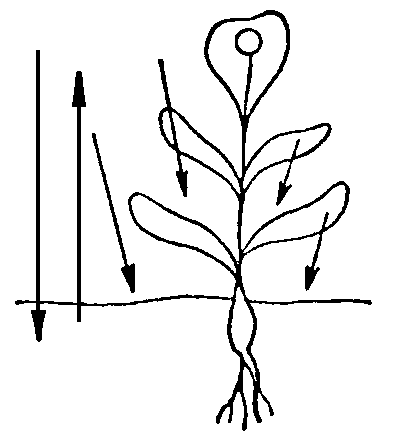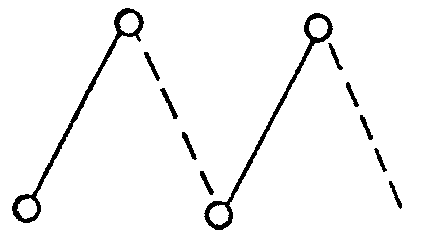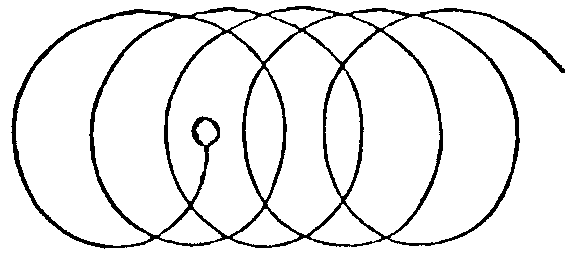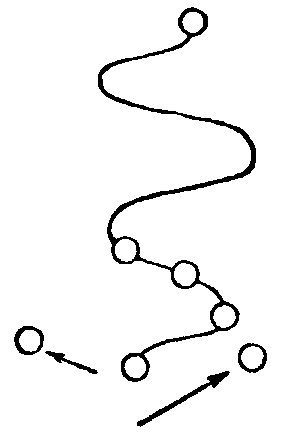Man—Hieroglyph of the Universe
GA 201
Lecture Two
10 April 1920, Dornach
Let us continue our studies of yesterday. I then drew your attention to the fact that at the present period in human thought we compress the whole world within abstract lines of space, standing perpendicular to one another and forming the three dimensions of space, whereas in its life aspect this three-dimensional world proves to be much more complicated and much more concrete. In order to gain an adequate conception of all that this means, we must grasp it in even greater definition.
We must ask the question: If it is true that our Thinking is to be associated with the vertical plane which cuts through our axis of symmetry, our Willing with the vertical plane which stands perpendicularly to the thought-plane, while the plane of Feeling rests at right angles to both—how is it that we do not experience above and below, right and left, in front and behind, as three directions distinct in quality from each other and not interchangeable? How is it that we simply feel them as three space dimensions of equal value? We certainly speak of length, breadth and height, but if we form our three planes in this way, each one resting vertically upon the other, we might place the line which was horizontal in the first instance in a vertical position, and the other two would then become horizontal. In short, we could make three different arrangements. This only shows that the exactitude with which these three dimensions are built into the human body, when it is being used by man to describe and explain the whole Universe with the Sun and the stars, is made quite abstract.
The question is important: How do we manage to obtain abstract space dimensions from concrete ones? An animal could not do this! An animal would always feel its plane of symmetry as a concrete ‘symmetry’ plane, and it would not relate this symmetry plane to any abstract direction, but would at most, if it could think at all in the human sense, feel the turning (from one plane to another). The animal in fact does feel this turning as a deviation of its symmetry plane from the normal. Herein lie important and essential problems of Zoology, which will once again be illustrated as soon as man studies them from the standpoint of their impulses in reality.
The reason that animals can find direction, as is shown most clearly of all in the case of the migration of birds, is because they do not feel the three directions of space in a nebulous way, but feel themselves as part of a quite definite direction of space, and feel each departure from this direction as an angle, as a deviation.
Now, if we wish to understand how all this applies to man, we must call to our assistance what we have already learned about the organisation of the human body. We have heard that man is a threefold being, consisting firstly of the characteristic head organisation, which does not of course include the head alone but chiefly functions there, and extends all over the rest of the body. Then there is what I will designate as the ‘Circulation man’—all that belongs to lung and heart, and represents Rhythm in man. And lastly there is the ‘Limb’ man, which also continues inward and constitutes that part of man which is connected with metabolism or the transmutation of substance.
It now behoves us to study this three-membered man more closely. We will first think of him as Head man, Rhythmic man and Limb man. Of these three, only the third with its continuation inwards is strongly connected with the forces—not the substances, but the forces of our terrestrial planet.
This does not apply to the Head man, for what is he? (We are not now considering anything substantial but the forces, the formative forces which condition him.) The Head man is the metamorphosis of the Limb man of the previous incarnation. The forces that formed the Limb man in the last incarnation, have, during the period between the last death and the last birth—that birth which brought us into our present existence—been in a world which we have often described. There they were metamorphosed so that they could now form the head. Thus the Head man and the Limb man are complete polar opposites, and the central, Rhythmic man is the adjustment between the two, balancing or reconciling them by means of Rhythm.
This antithesis between the Head man and the Limb man must be still further examined. We shall, perhaps, be able more easily to approach the matters it is necessary to understand in this domain, if we examine the following example taken from another sphere.

Consider the plant—not, for the moment, a perennial plant, but an annual which develops from seed to root and stem and during the year forms its fruit and seed. Such a plant grows from the seed that has been planted in the earth; out of the seed emerge the roots, then the leaves and the flowers, in which latter, during the fruit stage, is developed the new seed. This is the evolutionary cycle of the plant.
The plant proceeds from the seed-formation in the Earth, grows until it reaches the surface, when it receives the effects of the light—from the Sun—and the effects of warmth. Under these influences it grows still further and completes its cycle by returning again to the stage of seed-formation. But now, when it returns to the seeding period in autumn we have the plant not below in the soil but above the Earth; and here it has been during the whole summer, dependent upon extra-terrestrial influences. These influences helped to promote its growth to the point of new seed-formation; it has therefore grown to the point of a fresh seed-formation not under the influences of the Earth, but while drawn away from these by extra-terrestrial forces. It has become once more what it was before and yet something different. In what sense different? The completion of the new seed terminates the process of growth. Development ends here, and the cycle cannot be completed unless we take the seed from its own plane or region and return it once more to the Earth. That is to say, if we follow that seed up into the sphere in which it is beyond the earthly element, we must then bring it down again, under the Earth. Then once more it grows up towards Heaven, and then again we must bring it down again to Earth.

That is to say, further growth depends upon bringing the seed down again to a deeper level—we must return to the Earth that which has been generated by the forces of Heaven. Therefore it is not sufficient to consider the cycle merely from seed to seed. We are concerned with the fact that the plant in a sense outgrows itself, and when it has outgrown itself to a certain stage, we must bring it back again to its original place, where it is once more received by the same forces and the cycle begins anew.
We can now draw the process in a diagram. If we have here the Earth level, then the cycle of evolution for the plant must be drawn thus. But the plant must again return to Earth, and so if we draw several annual processes, we must advance a little further each time. There you have the difference of level. We must again and again bring the plant back to another level.
I have given you this as an illustration, and before we pass on, something else must be considered in connection with it. Notice the way in which the bean plant arises out of the seed. and you will understand what I mean. You will realise it still better, if you observe a plant with a twining stem, one that is naturally inclined not to grow up in a straight line if certain forces are able to act freely. The bindweed is an instance of such a plant.
Now let us pass on to consider this picture in connection with man. If instead of thinking of the yearly cycle of the plant, we turn our attention to that cycle which leads man from one earthly life, through the spiritual world, to the next earthly life, we have there something quite remarkably similar. Think of your limb organism in the previous incarnation, and your head in this incarnation. The head is formed through a metamorphosis, and it is only the visible change that is interrupted by all that takes place between death and a new birth. The head is formed in the same way as the new seed in the plant is formed out of the old. But the whole of the intermediate life of the plant lies between. So that we may say: From the point of view of the organisation of his form, it is as if in man the root existed in the previous incarnation, and out of this root has grown the head of the present incarnation. The head, therefore, represents something analogous to the seed. But in man all this takes place, one may say, upon a higher level—in a higher region—and is, besides, more complicated.
And now in order to complete this conception, think of the whole metamorphosis of the plant. If you observe the bindweed, you will see from the spiral or screw-like form of the stem, that the forces acting from outside are not such as to cause it merely to grow in a straight line, they induce it to grow in a spiral form. The plant has a tendency to spiral formation. Only when the new seed is developed, does the seed resist this tendency; it is entirely concentrated in this small grain. The seed then withdraws from the influence of the Universe. In the case of man the Limb man is most under the influence of the Earth. (In the Rhythmic man the case is different and we will speak about this later.) But the head is something which withdraws itself from the Earth-forces and takes no part in them, just as the seed takes no part in the extra-mundane influences. Only because the head withdraws from the Earth-forces are we men able to think in abstract thoughts. Were it impossible for our head to separate itself entirely from Earth influences, we could not think in the abstract.
This fact is indeed expressed in the form of man. Think for a moment that your head actually represents the transformed Limb man. The latter however walks upon the Earth's surface, not so the head. The head may be compared with a man who is comfortably seated in a motor car or in a train; he does not move and yet goes forward. The head is in this position in respect to the rest of the organism; the latter advances forward, and the head rests as though in a vehicle, not taking part in any of the movements, but withdrawing itself in a very evident way from the Earth forces. The head is like the man who lets himself be carried forward by other people.
Such is the organisation of the head of man. It withdraws from the Earth's influences, and we can therefore say: The head of man shows itself—at least in this comparison—similar to the seed that withdraws from the heavenly influences of plant-formation. But with man it is not the same as with the plant. The latter grows from the Earth upwards—towards the Heavenly influences. Man grows downwards. When he arrives at conception or birth, he is in the first place a head structure; external embryology affords absolute proof of this. He brings with him his head as a transformed product of the last incarnation. During this earthly life—through the forces of it—the Limb man develops most especially. It grows on to the head. It is less evolved than the head and entirely under the influence of the Earth forces. The head on the other hand is entirely withdrawn from the Earth forces. We can therefore say: When we observe plants, we can trace, in the spiral or screw-like construction, whence come the forces that give the plant its spiral form; they come from extra-terrestrial bodies. But when we consider man, and see how he grows towards the Earth, we must ask ourselves: What has given man this potentiality to grow in opposition to the laws governing the growth of the plant which grows upwards? For man grows downwards and gradually succumbs to the earthly influence. How is all this explained? This is a most important, indeed an essential question, concerning not only Morphology, the study of the human form, but the whole being of Man. You see, if we were obliged to live our soul-life without a head, it would be entirely different; we should be incapable of any abstract conceptions! Above all, we could not conceive of three-dimensional space as abstract, but would strictly differentiate between front and back, right and left, above and below. All these directions would be for us quite distinct in character. This is, in fact, what our organism does. As soon as you have advanced, through the methods of Spiritual Science, to the imaginative conception of the Universe, this comfortable three-dimensionality ceases. Now you must discriminate, for you have performed something quite remarkable—you have eliminated the ordinary organism of the head and have gone back to the etheric organism of man.
Now the etheric organisation is essentially different from the physical organisation of the head. It is only through the completely organised head, brought over to this incarnation from the previous one, that abstractions have become possible. All abstract thinking, all thinking on the plane of pure thought, is bound to this head organism, which we attain only by leaving the spiritual world and coming into this physical world, in order to make independent of the Earth-organisation that which formerly was dependent on it.
This will show you that Man, like the plant, is embedded into the earthly influences, but with this difference, that man makes himself independent of them through his head organism. If the rest of our organism were to think without the instrumentality of the head—as indeed it can—man would at once feel himself one with the whole organism of the Universe.
If it were possible to invent a very comfortable sleeping car—it is at the present time perhaps unlikely—but a car from which you did not look out and from which all noise and rattle were eliminated, you might fall into the illusion that you were in a still and silent room, for you would perceive nothing of its movement. But upon looking out of the window, you would see that it is moving forward, although you are sitting quietly in the car. Similarly, as soon as you also release yourself from the illusion which your head organism produces in you during the process of making itself independent of the Earth-organisation, you observe that you are taking part in the motion of the Earth. That is to say, it is possible, through the transition from what, in my book Knowledge of the Higher Worlds I have called the present-day mode of forming ideas to what I have called Imagination—it is possible to feel the movements of the Earth, because you are then ‘looking out of the window’. You look into the spiritual world. In just the same way as you look through the window of a train and notice the landscape outside continually changing, so do you, when looking out of the physical sense-world into the spiritual, perceive in the alterations in the latter as you pass by, that you with the Earth are not at rest, but moving forward. Hence we cannot arrive at a true astronomical space-conception if we insist upon constructing it just with that part of our organism which has made itself independent!
Consider for a moment what we as civilised humanity have done since the beginning of this Fifth post-Atlantean epoch. We have thought about the Universe with our head. And it is the head—that part of us which has made itself quite independent of the Earth—that has contracted the world-movements into the abstraction of the three dimensions. We have the Copernican conception of the Universe, designed for us by the least appropriate instrument, the head, the essential characteristic of which is its emancipation from co-operation in the world movements. It would be somewhat as though you wished to obtain an idea, shall we say, of the movement of a railway train in which you are traveling, from a picture of it you draw with your hand, without reference to the movement of the train, but solely according to your own ideas. You draw something; you make yourself independent. But you cannot consider such a drawing as depicting the movement of the railway train; it has nothing whatever to do with it! And just as little to do with the world-process has a picture of it that we have designed according to external spatial astronomy, using for the purpose the instrument that is the most inadequate for its conception.
Now just observe to what conclusion a really truthful and commensurate conception of things leads us. We are compelled to admit that our spatial astronomical picture of the world has been built up with the most inadequate means. No wonder it contradicts the results that are obtained when the proper instrument is used! Of course, for certain purposes this conception is well adapted, because since the middle of the fifteenth century, when the Fifth post-Atlantean period began, we have had gradually to learn to form thoughts independently of the Universe. We shall hear in the next lecture how that came about. But we have thereby lost the capacity of really knowing anything of the movements in which we have trained ourselves to feel concretely the otherwise abstract dimensions of space. We shall come back to these things again and again; for we cannot arrive at a complete picture in any other way than by building up our ideas, as it were, in cycles.

After yesterday's suggestions Dr. Stein has taken the trouble to construct a model showing the movements which result when we follow Man together with the Earth, or in other words the movement of the Earth taken in its absolute sense. If instead of following this time the motion of plant-forces in spirals, I follow the movements described by Man with the Earth, I again come upon a spiral, but one which is progressive. This spiral gives us an illustration of the real movement of the Earth, and at the same time a picture of that of the Sun. Suppose for a moment that the Earth is here and the Sun there. An observer sees the Sun in this direction. (diagram). The Earth progresses, but exactly in a line behind the Sun. When the Earth is here, the observer now sees the Sun in another direction. The Sun advances still further, the

Earth following, and once again the observer sees the Sun in the other direction. That is to say, he sees the Sun at one time on the right, and another time on the left, owing to the way in which the Earth follows the Sun.
This has been interpreted as demonstrating that the Sun stands still and the Earth revolves round it. In reality, it is not so; the Earth moves along behind the Sun. The observer sees the Sun to the right when the latter has arrived at one point of the spiral path, while the Earth is here. Next he sees the Sun to the left, then again right, then left, and so on. All this gives the observer, who judges by outward appearances and loses sight of his own movement, the impression that the Earth revolves round the Sun.
From this you will realise how great a possibility of deception arises when one judges by exterior appearances; for here indeed a relativity of motion exists. We can really affirm that those who now calculate the apparent motion of the Sun do not perceive their own motion, and omit to take into consideration the relation between the Sun and the Earth.
I should like you to try to form a true idea of what I have said about course or motion in a screw-like line, because one must visualise, in a model such as this, the fact of the Earth following in the wake of the Sun; and then we shall be able to go on to what I should like us to attain tomorrow, namely a true understanding of the facts before us. Today I have intentionally given suggestions only, and purposely left many questions open, but they will be answered tomorrow or in one of the subsequent lectures. I wanted to show you in a quite simple way the experiences of one who looks out through the windows of the physical world, and observes the spiritual world outside as it rushes by. In this way he can form an idea of the real motion of the Earth and also of the Sun.
But I will show you first how to gain a conception of the true relation of the Earth to the Sun—that the Earth actually follows the Sun in its path—by searching for the one thing that will show us this relationship, namely certain processes in the human organism connected with the representative of the Sun in man—the human heart. For it is by taking our start from the knowledge of Man that we must seek to attain to a knowledge of the Universe.

